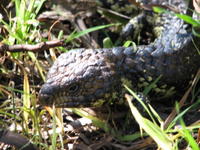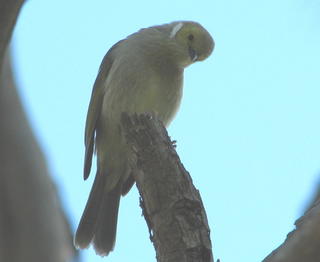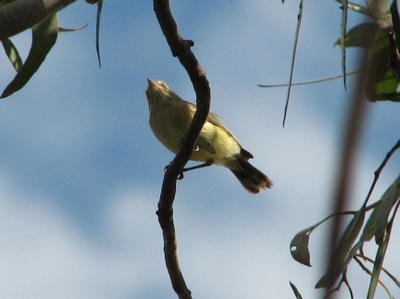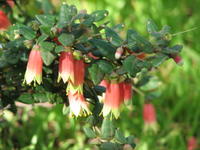Australian Ringneck
Working in the garden this afternoon I needed to stop what I was doing to take some photographs of a local species of parrot, the Australian Ringneck (also called Mallee Ringneck). I did not have to go looking for the bird in question. It was almost like it came looking for me! It flew right up to me in our plant nursery and sat on a nearby branch, not more than 3 metres away.
Of course, the camera was in the house, so I tried to casually walk into the house hoping that the ringneck would stay there. It didn’t but flew to a tree some 50 metres away. I continued working, all the time watching for the bird to return. I didn’t have to wait long. It settled in a tree near the house. I quietly went inside with the camera, planning to use our sun-room as a hide. We have three bird baths about six metres from a large picture window. We have had hundreds of very enjoyable meals watching the parade of birds coming to drink or bathe. Again, a very “good” waste of time, being very relaxing and enjoyable.
Today’s visitor was taking quite a deal of interest in the water. After taking some good photos through the window I decided to go outside and see how close I could get to the ringneck. I was able to get to about 3 metres away while the bird came down to the bird-bath and proceed to have a very thorough bath. I managed to get several more excellent photos. I then pressed the video button on the camera and filmed the bird washing and preening for about two minutes. I haven’t yet worked out whether I can make this video available on this blog.
Usually we have only two Australian Ringnecks around in the garden. In recent months there have been four, two of them juveniles. They aren’t in our garden constantly but rather roam over a wide range of the local environment. We usually love seeing them near to the house like today. When they decide to raid the orchard and nip the buds off the pear and apple trees we get just a tad annoyed – no – angry. We also get no fruit! Today I observed only one bird; I wonder if the other is nesting somewhere?
Little Brown Birds
I have started photographing birds in the wrong way. I have taken on those LBBs (Little Brown Birds) which cause so much angst amongst birders. Some of them are annoyingly difficult to identify, even when conditions seem good.
 They are sometimes hard to get good views of even when they sit still. Some of them never seem to sit still for even a second. Then they are too far away to be certain about the ID or they are partly obscured by foliage, twigs or branches. The opposite is sometimes a problem; too close to focus one’s binoculars yet too far away for the naked eye!
They are sometimes hard to get good views of even when they sit still. Some of them never seem to sit still for even a second. Then they are too far away to be certain about the ID or they are partly obscured by foliage, twigs or branches. The opposite is sometimes a problem; too close to focus one’s binoculars yet too far away for the naked eye!
Our little patch of mallee scrub has an interesting set of LBBs on tap just waiting to annoy me and to engage me in an identification detective trail through several field guides. One species is simple; the Yellow-Rumped Thornbill has a very bright yellow rump displayed prominently as they fly off. The Yellow Thornbill is easily confused with it if the shadows are playing tricks with your eyes; fortunately this species is not resident on our property. It is an occasional visitor.
The Chestnut-Rumped Thornbill, another occasional visitor, should be easy to identify, but this species is easily confused with the Inland Thornbill. Fortunately I’ve only recorded this latter species on one occasion on our property. Still, it shows that one has to be ever vigilant and not assume anything.
 Throw into this mess the smallest LBB of all, the Weebill. It is also Australia’s smallest bird. Sometimes the trees around us just burst into song from these delightful little birds. It can seem the the trees themselves are singing. Combine that with the peacefulness of our scrub, the bright sunshine and soft breeze, having to get on with tasks becomes a real challenge in discipline. Much easier to sit back and enjoy the day. Mind you, we sometimes do just that, cuppa in hand. It is a “good” waste of time, our equivalent of taking time to “smell the roses.”
Throw into this mess the smallest LBB of all, the Weebill. It is also Australia’s smallest bird. Sometimes the trees around us just burst into song from these delightful little birds. It can seem the the trees themselves are singing. Combine that with the peacefulness of our scrub, the bright sunshine and soft breeze, having to get on with tasks becomes a real challenge in discipline. Much easier to sit back and enjoy the day. Mind you, we sometimes do just that, cuppa in hand. It is a “good” waste of time, our equivalent of taking time to “smell the roses.”
Having said all of that I feel reasonably confident that the three photos in today’s blog are in fact Weebills. Well, I’m not too sure of the last photo; the bill seems too pointed.
Going cuckoo
 I haven’t added an entry for several days. I had a busy weekend and the only free time was taken up watching the amazing battle between Australia and England in the Fifth and deciding Ashes Cricket Test. Watching cricket is another of my passions. I often accompany my daughter Rose to the test cricket at the world’s most beautiful cricket ground, the Adelaide Oval.
I haven’t added an entry for several days. I had a busy weekend and the only free time was taken up watching the amazing battle between Australia and England in the Fifth and deciding Ashes Cricket Test. Watching cricket is another of my passions. I often accompany my daughter Rose to the test cricket at the world’s most beautiful cricket ground, the Adelaide Oval.
My only observation of note today was hearing a Horsfield’s Bronze-Cuckoo near the house. Try as I might I couldn’t even get a glimpse of said cuckoo, never mind attempting to get a photograph. The first cuckoo of the spring I heard about two weeks ago and then only for a few seconds. Today’s individual hung around for about an hour.
 Spring is well and truly under way here in Murray Bridge. Many birds are busy breeding, native plants are flowering and exotics like roses are sprouting new leaves in profusion. We have a few vines are they are also showing their first leaves. In our small orchard the fruit trees are either in blossom and have buds about to burst. The above photo shows a beautiful Nectarine blossom. The second photograph shows the magnificent bloom of the Grevillea “Winpara Gem”, a popular Australian plant.
Spring is well and truly under way here in Murray Bridge. Many birds are busy breeding, native plants are flowering and exotics like roses are sprouting new leaves in profusion. We have a few vines are they are also showing their first leaves. In our small orchard the fruit trees are either in blossom and have buds about to burst. The above photo shows a beautiful Nectarine blossom. The second photograph shows the magnificent bloom of the Grevillea “Winpara Gem”, a popular Australian plant.
I have noticed that the Crested Pigeons are not very conspicuous at present. I  wonder if they are nesting somewhere? I must have a good snoop around tomorrow. Meanwhile, here is another beautiful photograph of one of the local Crested Pigeons sun-bathing near the house last week.
wonder if they are nesting somewhere? I must have a good snoop around tomorrow. Meanwhile, here is another beautiful photograph of one of the local Crested Pigeons sun-bathing near the house last week.
How sweet it is
I have been trying for several days to capture a New Holland Honeyeater doing their usual gymnastic tricks while feeding. Just before lunch today I managed to get one upside down feeding from a flower in an Eremophila youngii. Eremophilas are commonly called Emu Bushes.

No – I haven’t inserted the photograph upside down! It’s the bird that is upside down. The curved beaks of the Ausralian honeyeaters are ideally suited to feeding from many of the Australian plants like the Eremophilas, Correas and Prostantheras with their tube shaped flowers. Of course the New Holland Honeyeaters don’t have it all to themselves. The Red Wattlebirds also insist on their fair share of the spoils. The above photo shows a Red Wattlebird busy in another eremophila nearby. A few seconds after this photo was taken a New Holland Honeyeater tried to chase the wattlebird away, only to have the tables turned and become the one being chased.
Of course the New Holland Honeyeaters don’t have it all to themselves. The Red Wattlebirds also insist on their fair share of the spoils. The above photo shows a Red Wattlebird busy in another eremophila nearby. A few seconds after this photo was taken a New Holland Honeyeater tried to chase the wattlebird away, only to have the tables turned and become the one being chased.
 Wattlebirds can be bossy creatures, especially if another bird tries to muscle in on their patch of food. The above photo shows a rare moment in the life of a Red Wattlebird – sitting peacefully on a branch of a Eucalyptus citriodora or Lemon Scented Gum. On closer inspection of the photo I just realised that this individual is keeping the above eremophila plant under surveillance.
Wattlebirds can be bossy creatures, especially if another bird tries to muscle in on their patch of food. The above photo shows a rare moment in the life of a Red Wattlebird – sitting peacefully on a branch of a Eucalyptus citriodora or Lemon Scented Gum. On closer inspection of the photo I just realised that this individual is keeping the above eremophila plant under surveillance.
 My new interest in butterflies continues unabated. I didn’t realise how many butterflies we have around our garden until I started quietly stalking them, camera poised. Today I managed several reasonable shots of the Vanessa kershawi or the Australian Painted Lady butterfly. We have at least two other species common in our garden, but I have yet to get a good shot of them. I know of at least two other species that have visited in the past but I haven’t seen them for several years.
My new interest in butterflies continues unabated. I didn’t realise how many butterflies we have around our garden until I started quietly stalking them, camera poised. Today I managed several reasonable shots of the Vanessa kershawi or the Australian Painted Lady butterfly. We have at least two other species common in our garden, but I have yet to get a good shot of them. I know of at least two other species that have visited in the past but I haven’t seen them for several years.
Here’s another challenge I could set myself. Try to get some photos of the dragonflies we have around here! Then I could move on to other insects, such as ants and beetles. And what about caterpillars? Oh, and then we have quite a selection of reptiles, including Brown Snakes (which are very dangerous so I don’t want to get too close; the zoom lens will help there).
 As for lizards, they are on the move already. I have included a photo taken yesterday of a Stumpy-Tailed Lizard (also called a Shingleback). We have quite a few individuals on our little estate. I haven’t seen any young Stumpy-Tails for a few months. We did see several in the autumn months. We enjoy seeing them come to one of the bird baths for a drink. The Aussie expression “flat out like a lizard drinking” is so apt. To illustrate how common this species is in the Murray Bridge area, our local poetry competition is called “The Stumpies”. I’ll try to get a link to details of this award.
As for lizards, they are on the move already. I have included a photo taken yesterday of a Stumpy-Tailed Lizard (also called a Shingleback). We have quite a few individuals on our little estate. I haven’t seen any young Stumpy-Tails for a few months. We did see several in the autumn months. We enjoy seeing them come to one of the bird baths for a drink. The Aussie expression “flat out like a lizard drinking” is so apt. To illustrate how common this species is in the Murray Bridge area, our local poetry competition is called “The Stumpies”. I’ll try to get a link to details of this award.
We also have a range of geckoes and skinks on our land, all of them quite beautifully marked and would make wonderful photographs to include in this journal. Then we have the following mammals present (or occasional visitors): Western Grey Kangaroo, Common Brushtail Possum, Short-Beaked Echidna, Brown Hare*, European Rabbit*, House Mouse*, Black Rat*, Red Fox* and feral cat*(*introduced). I am sure we probably also have four or five species of bats but I’ve only indentified the Western Broad-Nosed Bat.
Mmmm… methinks I’ve opened a can of worms here!
Worms???
How photogenic are worms??
PS. I’m so pleased I do not have to buy film for this new camera.
Hi there honey – encounters with honeyeaters
We are not short of honeyeaters in Murray Bridge. They are common everywhere in this district and are probably the most common bird in most people’s gardens. Other species may outnumber them along the river or in the farming areas. For example, Straw-Necked Ibis numbers along the dairying flats are very numerous. I have seen flocks of over 400 on many occasions. Flocks of Galahs of that size are also evident, especially where wheat is cultivated. Along the parks and trees lining the River Murray large flocks of Little Corella can also be seen on occasions.
In the gardens, however, the honeyeater species tend to dominate. We do have some Noisy Miners in the area but they are not (yet) the dominent species they seem to be in other parts of Australia. In the Murray Bridge district New Holland Honeyeaters probably outnumber all other species of honeyeater.  Red Wattlebirds are also very common as are White-Plumed Honeyeaters.
Red Wattlebirds are also very common as are White-Plumed Honeyeaters.
Last Monday we went to visit my wife’s mother. She lives in a retirement village, Murraylands. Part of the complex opposite her unit is a plantation of native Australian plants, established 20 years ago and maintained by the local members of the Australian Plant Society. The local group is in recess due to lack of members, Corinne (my wife) is the immediate past-president and I am also a past-president.
While Corinne was collecting cuttings for propogation I was taking photographs of various flowers for her. (I have included several photos at the end of this posting.) There were many birds in the locality, including a number of White Plumed Honeyeaters. Two of them came close to investigate what I was doing, so I took several photographs. I was basically shooting into the sun so the photos are not candidates for “Best of Show” in an exhibition. They turned out quite dark so I have enhanced them to show them here. I only include them here because of the unusual stance of the birds.
 The first photo (above) shows one bird looking straight down at me. The eyes are what caught my attention. It’s a rather bizarre view of a bird. The second photo shows the other bird’s response to the focussing beep on my camera. It obviously heard the soft beep as I focussed. Pity about the lack of colour.
The first photo (above) shows one bird looking straight down at me. The eyes are what caught my attention. It’s a rather bizarre view of a bird. The second photo shows the other bird’s response to the focussing beep on my camera. It obviously heard the soft beep as I focussed. Pity about the lack of colour.
The native plant garden at Murraylands Homes is about an acre in size. It includes a wide range of Australian plants, including eucalypts, wattles, grevilleas, correas, eremophilas, callistemons and many others. Below I have included a selection of the shots I took.






